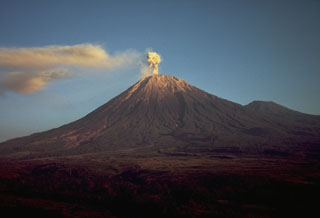Report on Semeru (Indonesia) — 26 February-3 March 2020
Smithsonian Institution / US Geological Survey
Weekly Volcanic Activity Report, 26 February-3 March 2020
Managing Editor: Sally Sennert.
Please cite this report as:
Global Volcanism Program, 2020. Report on Semeru (Indonesia) (Sennert, S, ed.). Weekly Volcanic Activity Report, 26 February-3 March 2020. Smithsonian Institution and US Geological Survey.
Semeru
Indonesia
8.108°S, 112.922°E; summit elev. 3657 m
All times are local (unless otherwise noted)
PVMBG reported that during February and 1-2 March gray eruptive plumes rose 200-500 m above Semeru’s summit. Beginning on 26 February incandescent material was ejected 10-50 m above the Jonggring-Seloko Crater, and by 2 March lava flows had traveled 500-1,000 m down the Kembar, Bang, and Kobokan drainages (on the S flank). The Alert Level remained at 2 (on a scale of 1-4), and the public was reminded to stay outside of the general 1-km radius from the summit and 4 km on the SSE flank.
Geological Summary. Semeru, the highest volcano on Java, and one of its most active, lies at the southern end of a volcanic massif extending north to the Tengger caldera. The steep-sided volcano, also referred to as Mahameru (Great Mountain), rises above coastal plains to the south. Gunung Semeru was constructed south of the overlapping Ajek-ajek and Jambangan calderas. A line of lake-filled maars was constructed along a N-S trend cutting through the summit, and cinder cones and lava domes occupy the eastern and NE flanks. Summit topography is complicated by the shifting of craters from NW to SE. Frequent 19th and 20th century eruptions were dominated by small-to-moderate explosions from the summit crater, with occasional lava flows and larger explosive eruptions accompanied by pyroclastic flows that have reached the lower flanks of the volcano.
Source: Pusat Vulkanologi dan Mitigasi Bencana Geologi (PVMBG, also known as CVGHM)

